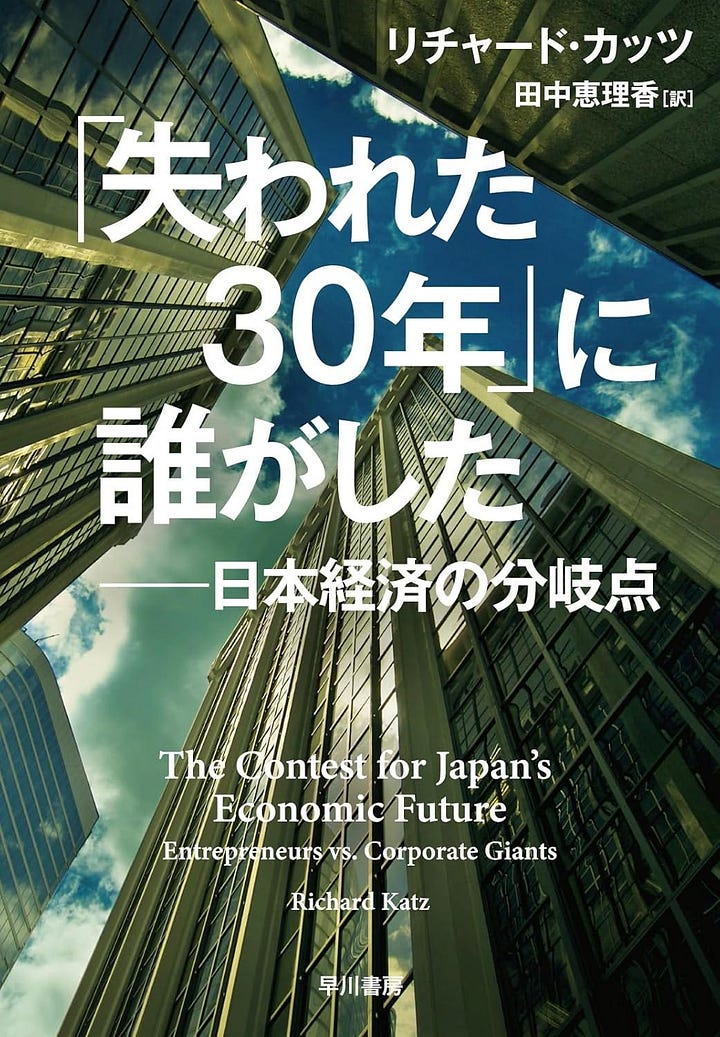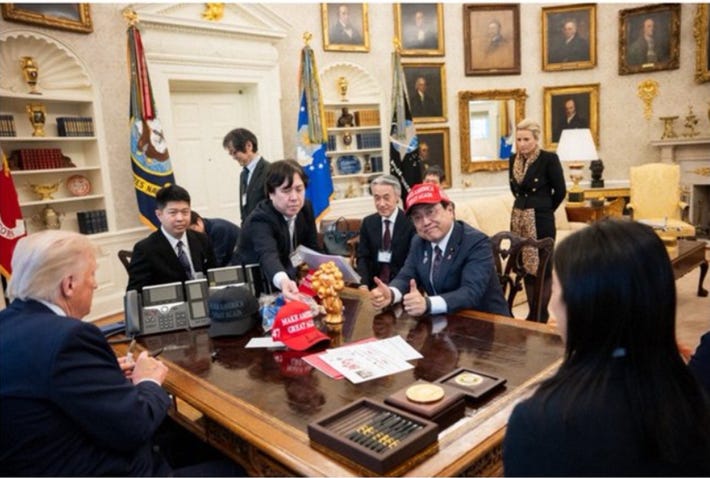Japanese Government and Business Stiffen Resistance to Trump
Trump Contradiction: Asking Japan to Buy More US Farm Goods While Making Them Price-Prohibitive
Source: The White House
When I arrived in Tokyo at the beginning of April, it looked as if Tokyo’s strategy for dealing with Trump’s trade war was to placate the bully. By the time I left three weeks later, Tokyo’s spine had stiffened. Moreover, business leaders—including the automakers hit with an ongoing 25% tariff—told the government they would rather endure the tariffs than cave in to outrageous demands that could lead Trump to make still more demands. What changed Tokyo’s stance was the panic in the financial markets that, on April 9th, forced Trump to retreat, albeit only partially and perhaps only temporarily. Japan sees these markets as its ally.
On April 2, Donald Trump declared “reciprocal” tariffs of 24% on Japan and as high as 50% on hosts of countries around the world, including some virtually uninhabited islands; plus 25% on vehicles and auto parts: another tariff of similar size to be placed on semiconductors and pharmaceuticals: and a 10% across-the-board tariff on all imports. In a February summit, Trump had demanded of Prime Minister Shigeru Ishiba that Japan eliminate its $70 billion trade surplus with the US. He claimed it would be easy. He repeated the demand during April 16 negotiations in DC. In response to all this, Japan tried to placate Trump, refused to cooperate with other nations suffering similar abuse, and asked for special exemptions for Japan at the expense of others. In fact, one of the reasons Trump chose Japan for the first round of trade talks was his belief that Tokyo would cave within a few weeks, thereby inducing others to do likewise.
The perception of Japan as supine was reinforced when Japan’s chief negotiator, Ryohei Akazawa, submitted to the humiliation of wearing a MAGA hat in front of Trump and giving him a Trumpian thumbs up (see photo at the top). To all the world, he made Japan look like a spineless supplicant. This was less a reflection of Japan’s stance than Ishiba’s folly in choosing Akazawa, an amateurish political buddy, rather than someone less loyal to him but more adept at handling contentious and humiliating demands. A retired official told me they are trained to find non-abrasive ways of evading attempts to put them in a subservient position.
By the time I left Japan three weeks later, the tables had turned. Japan is resisting Trump by focusing on virtually meaningless agenda items based on some of Trump’s own rhetorical rants, e.g., auto safety rules (see details in Part 2), and the tactic of delay. The turning point was Trump’s partial retreat on April 9 in the face of financial market panic. Government officials and business executives alike told me they had faith that markets would continue to rebel when Trump overreached. Moreover, that when markets rebelled, Treasury Secretary Scott Bessent would be willing and able to convince Trump to backstep, as he reportedly did on April 9th. Then, of course, Tokyo is quite aware of Trump’s falling approval ratings. No one can tell whether Japan’s perception will prove correct over time, but it is guiding policy for now.
Added to the financial markets factor is a sense of confidence and spirit of resistance among Japan’s giant multinational companies. They feel that they will suffer less than their American counterparts and are well-positioned to endure the pain. Frankly, I was surprised by the degree of unanimity on this. I had wondered whether the automakers might want to pressure the government to make concessions to get the 25% tariffs on them lifted. However, a Toyota-linked businessman said the opposite was the case. They are asking Tokyo not to acquiesce to a bad deal. Ironically, the most ardent leader in this resistance is Toyota, which initially celebrated Trump’s re-election because of his opposition to electric vehicles. The automakers believe that they are in a strong position, aside perhaps from the more fragile Nissan. Firstly, there is still robust demand for their cars. And the still-cheap yen enables them to make profits even if they have to absorb some of the tariffs to limit the price hike their American customers face. Moreover, they say American tariffs against Mexico will hurt Detroit and American parts makers more than Japan. They have a point: American-made parts make up 75% of the value of cars that Mexico assembles and sends to the US. Many of the blue-collar workers who voted for Trump are going to lose their jobs and suffer more inflation.
A final factor in Japan’s thinking is the fear that Trump’s attacks on America’s friends and allies could make China the big winner in the trade war. Xi Jinping is trying to present China as the defender of rules-based trade against Trump’s arbitrary ripping up of the rules.
Trump Misreads Japan And The Markets
It’s not just the revolt of the financial markets that weakens Trump. As it turns out, the self-described “world’s greatest negotiator” is so inept that he’s weakening himself. He keeps making offers that others have to refuse.
Trump chose Japan as the first big country to negotiate with, because he figured Tokyo would quickly cave. He acted like a cop who captures four thieves, puts each of them in a separate room, offers a lighter sentence to the first to confess, and then lies that the guy in the next room is minutes away from spilling his guts. So, you better confess before he does. The problem is that Trump is terrible at this. How many times have Trump and/or his subordinates falsely proclaimed that an agreement was just a week away? How is it that Trump says he’s made 200 agreements, but his cabinet members cannot name even one? How many times has Trump claimed they were negotiating with China—or that Xi Jinping had called him— only to have Beijing repeatedly deny it and have people believe Beijing instead of him?
Trump further undercuts himself by refusing to say what it would take to satisfy him, beyond the impossible goal of eliminating Japan’s bilateral trade surplus. He believes this puts the other side off balance. But why should Japan negotiate with itself by offering sweeter and sweeter packages, only for Trump to ask for more? Again and again, policymakers and business executives asked me: What does Trump want? I had to answer: eliminating the trade deficit, even though there is no way to achieve that. Like the White Queen, he has taught himself to believe six impossible things before breakfast. It’s a mistake to think Trump is guided by some realistic grand strategy. On the contrary, he is a creature of emotion, resentment, and lies that turn into delusions. How grounded in reality is Trump when he declares, “the European Union was formed to screw the US?” Or that Japanese automakers drop bowling balls on US cars and fail them if this creates a dent? Unlike in his first term, this time he has refused to hire people who can contain his recklessness. Bessent is just as ideological as Trump, just less pathological and more attuned to the financial markets.
Beyond that, Trump sabotages his demands on one country via his demands on others. He is incapable of recognizing obvious trade-offs. For example, Trump demands that Asian countries like Japan buy more farm products from the US at the expense of other suppliers like China and Australia. (The US is Japan’s largest supplier with a 20-24% share.) On the other hand, to reduce the share of US exports and imports handled on Chinese-owned ships—now amounting to perhaps one-third—he has imposed a $50 fee per ton of cargo on Chinese ships using a US port. This will begin in October and rise to $120 by 2028. With US wheat around $235 per ton, and prices for corn and soybeans in the same ballpark, Trump has made freight costs prohibitive. Not surprisingly, then, Asian buyers are “shunning” US farm goods in favor of other suppliers. Even if Tokyo wanted to satisfy Trump on agricultural products, it could not do so. Unless, of course, it operated the kind of command economy Trump seeks to create in the US and could bully companies into choosing the highest-price supplier. Trump may get a thank-you note from farmers in China, Australia, and the EU.
Finally, no one can trust Trump to comply with the deals he has negotiated. In 2019, when the US and Japan reached a trade agreement, Trump promised Shinzo Abe that he would not increase auto tariffs, nor use “Section 232” (regarding security allegations) to evade that promise. But that’s exactly what his current 25% automotive tariffs do via the use of Section 232. Ishiba publicly complained about the broken promise. Trump’s repeated betrayals, in effect, tell Tokyo not to make new concessions when they may not get what they paid for. Trust destroyed is not easily regained.
Japan’s Change of Heart
In reaction to all this, it seems that Japan is offering some “ trinkets” worth a few billion dollars and playing “delay, delay, delay” in the hope that financial markets and Bessent eventually bring Trump to his senses. In the April 16 meeting, the US and Japan talked of reaching an agreement “as soon as possible,” and Trump falsely touted “great progress.” The following week, Ishiba told the Diet that “haste makes waste” and that he would not make bad compromises to get a quick deal.
Ishiba now says that Japan needed to coordinate with Southeast Asian nations since any US-Japan pact would serve as a model for other countries. This reverses Japan’s past stance of rejecting coordination in favor of a go-it-alone strategy. But, given the distrust of Trump, a number of senior policymakers and business leaders told me that they now favored such coordination. However, they added, there was no consensus on whether or not to do that, let alone what such coordination might entail.
Tokyo also said it rejected US demands that it increase its own impediments to imports from China as a condition of obtaining a decrease in US tariffs. The US has placed this demand on many countries. Bessent expressed hope of reaching an agreement with America’s major trading partners and “then we can approach China as a group.” Once again, the Trumpists are caught in their own contradictions. For example, Washington wants companies to move their production out of China. On the other hand, as a Wall Street Journal editorial pointed out, Trump’s tariffs on India, Vietnam, and others make that shift more difficult. But, for Trump, moving out of China is only satisfactory if it means moving to the US. He doesn’t believe in “friendshoring.” There is a gap on this issue between Bessent and Trump. Bessent is far more focused on containing China and is willing to lighten up on tariffs with nations that cooperate in an anti-China bloc. Trump, by contrast, sees every nation, friend and foe alike, as predatory.
Coming Up In Part 2: What are the specific issues in the US-Japan trade talks? Even if Japan conceded on all of these, would they slash the trade deficit? (Hint: don’t bet your life)
Yomiuri Shimbun (6 million buyers) ran a favorable review of my book as the lead in its book review section on Sunday. I’ll have a translation in a future blog.


To receive new posts and support my work, consider becoming a free or paid subscriber.
To provide more support, donate several subs at $50 each. You do not need to name the sub recipients, just how many. This is a one-time contribution; it does not repeat automatically. Please click the button below.



Great post. Rome is indeed burning.